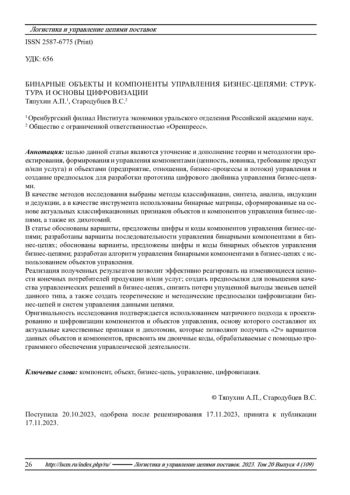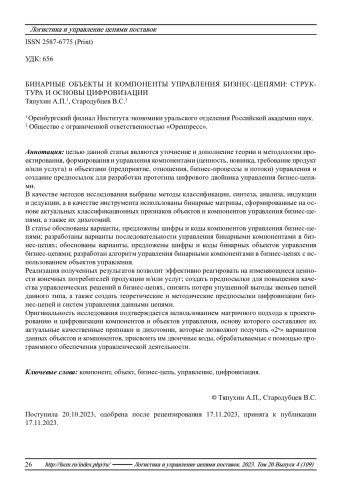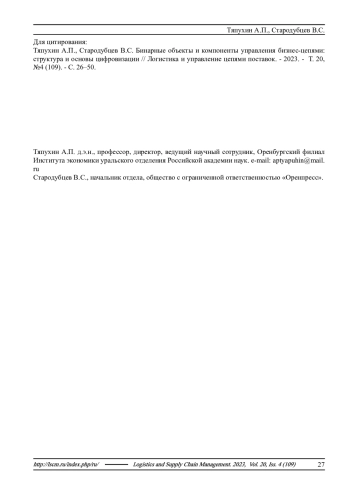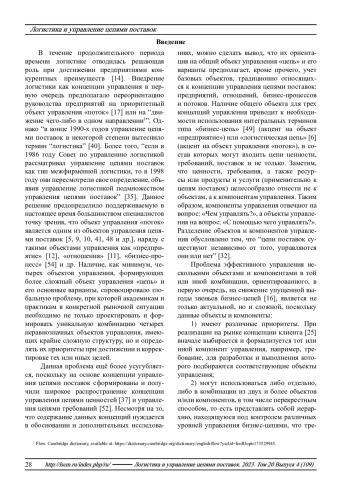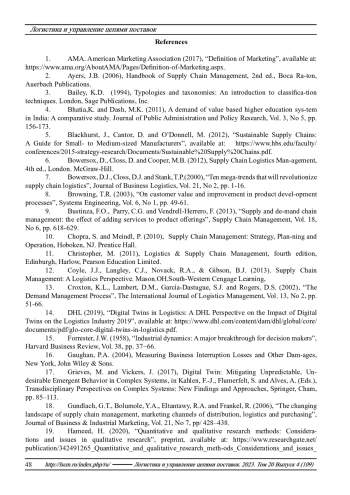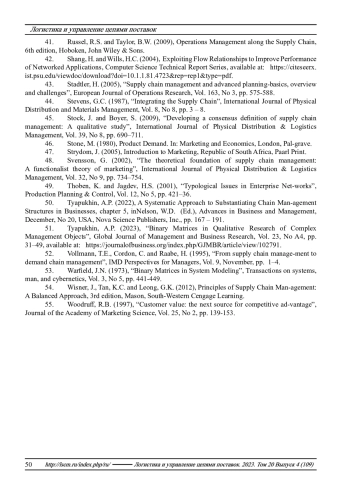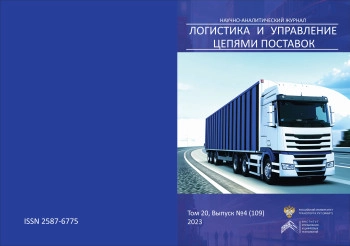1. AMA. American Marketing Association (2017), “Definition of Marketing”, available at: https://www.ama.org/AboutAMA/Pages/Definition-of-Marketing.aspx (Accessed 10 January 2024).
2. Ayers, J.B. (2006), Handbook of Supply Chain Management, 2nd ed., Boca Raton, Auerbach Publications.
3. Bailey, K.D. (1994), Typologies and taxonomies: An introduction to classification techniques. London, Sage Publications, Inc.
4. Bhatia,K. and Dash, M.K. (2011), A demand of value based higher education system in India: A comparative study. Journal of Public Administration and Policy Research, Vol. 3, No 5, pp. 156-173.
5. Blackhurst, J., Cantor, D. and O’Donnell, M. (2012), “Sustainable Supply Chains: A Guide for Small- to Medium-sized Manufacturers”, available at: https://www.hbs.edu/faculty/conferences/2015-strategy-research/Documents/Sustainable%20Supply%20Chains.pdf (Accessed 10 January 2024).
6. Bowersox, D., Closs, D. and Cooper, M.B. (2012), Supply Chain Logistics Management, 4th ed., London. McGraw-Hill.
7. Bowersox, D.J., Closs, D.J. and Stank, T.P.(2000), “Ten mega-trends that will revolutionize supply chain logistics”, Journal of Business Logistics, Vol. 21, No 2, pp. 1-16. EDN: FNKIXN
8. Browning, T.R. (2003), “On customer value and improvement in product development processes”, Systems Engineering, Vol. 6, No 1, pp. 49-61.
9. Bustinza, F.O., Parry, C.G. and Vendrell-Herrero, F. (2013), “Supply and demand chain management: the effect of adding services to product offerings”, Supply Chain Management, Vol. 18, No 6, pp. 618-629.
10. Chopra, S. and Meindl, P. (2010), Supply Chain Management: Strategy, Planning and Operation, Hoboken, NJ. Prentice Hall.
11. Christopher, M. (2011), Logistics & Supply Chain Management, fourth edition, Edinburgh, Harlow, Pearson Education Limited.
12. Coyle, J.J., Langley, C.J., Novack, R.A., & Gibson, B.J. (2013). Supply Chain Management: A Logistics Perspective. Mason.OH.South-Western Cengage Learning.
13. Croxton, K.L., Lambert, D.M., García-Dastugue, S.J. and Rogers, D.S. (2002), “The Demand Management Process”, The International Journal of Logistics Management, Vol. 13, No 2, pp. 51-66.
14. DHL (2019), “Digital Twins in Logistics: A DHL Perspective on the Impact of Digital Twins on the Logistics Industry 2019”, available at: https://www.dhl.com/content/dam/dhl/global/core/documents/pdf/glo-core-digital-twins-in-logistics.pdf (Accessed 10 January 2024).
15. Forrester, J.W. (1958), “Industrial dynamics: A major breakthrough for decision makers”, Harvard Business Review, Vol. 38, pp. 37-66.
16. Gaughan, P.A. (2004), Measuring Business Interruption Losses and Other Damages, New York, John Wiley & Sons.
17. Grieves, M. and Vickers, J. (2017), Digital Twin: Mitigating Unpredictable, Undesirable Emergent Behavior in Complex Systems, in Kahlen, F.-J., Flumerfelt, S. and Alves, A. (Eds.), Transdisciplinary Perspectives on Complex Systems: New Findings and Approaches, Springer, Cham, pp. 85-113.
18. Gundlach, G.T., Bolumole, Y.A., Eltantawy, R.A. and Frankel, R. (2006), “The changing landscape of supply chain management, marketing channels of distribution, logistics and purchasing”, Journal of Business & Industrial Marketing, Vol. 21, No 7, pp/ 428-438.
19. Hameed, H. (2020), “Quantitative and qualitative research methods: Considerations and issues in qualitative research”, preprint, available at: https://www.researchgate.net/publication/342491265_Quantitative_and_qualitative_research_methods_Considerations_and_issues_in_qualitative_research/link/5ef6c13b92851c52d60064b5/download (Accessed 10 January 2024).
20. Handfield, R.B. and Nichols, E.L. (2003), Introduction to Supply Chain Management, 2nd edition, Upper Saddle River, Prentice Hall.
21. He, Y. and Zhao, X. (2012), “Coordination in multi-echelon supply chain under supply and demand uncertainty”, International Journal of Production Economics, Vol. 139, No 1, pp. 106-115.
22. Humphries, A. and McComie, L. (2022), Enterprise Relationship Management: Making collaborative performance certain, third edition, Great Britain, SCCI Ltd.
23. Kemper, B., de Mast, J. and Mandjes, M. (2010), “Modeling process flow using diagrams”, Quality and Reliability Engineering International, Vol. 26, No 4, pp. 341-349.
24. Kotler, P. (1967), Marketing Management: Analysis, Planning, and Control, Prentice-Hall.
25. Kumar, V., & Reinartz, W. (2006). Customer Relationship Management Concept, Strategy, and Tools, third edition, Germany. Springer-Verlag GmbH.
26. LaLonde, B.J. (1997), “Supply chain management: Myth or reality?”, Supply Chain Management Review, Vol. 1, Spring, pp. 6-7.
27. Lancaster, K. (1975), “Socially optimal Product Differentiation”, American Economic Review, Vol. 65, No 9, pp. 567-585.
28. Lazzarini, S.G., Chaddad, F.R. and Cook, M.L. (2001), “Integrating supply chain and network analysis: the study of netchains”, Journal on chain and network science, Vol. 1, No 1, pp. 7-22.
29. Loanne, S.S. and Webster, C.M. (2014), “Consumer-to-consumer value within social networks”, The Marketing Review, Vol. 14, No 4, pp. 447-462.
30. Martins, C.L. and Pato, M.V. (2019), “Supply chain sustainability: A tertiary literature review”, Journal of Cleaner Production, Vol. 225, No 10, pp. 995-1016.
31. Maia, J.L. and Cerra, A.L. (2009), “Interrelation between Supply Chain Management and Logistics: a case study in the Brazilian plant of a multinational automotive company”, Revista Gestão Industrial, Vol. 05, No 01, pp. 59-73.
32. Mentzer, J.T., DeWitt, W., Keebler, J.S., Min, S., Nix, N.W., Smith, C.D. and Zacharia, Z.G. (2001), “Defining supply chain management”, Journal of Business Logistics, Vol. 22, No 2, pp. 1-25. EDN: FNJLYF
33. Mowles, C. (2008), “Values in international development organizations: negotiating non-negotiables”, Development in Practice, Vol. 18, No 1, pp. 5-16.
34. Neap, H.S. and Celik,T.I. (1991), “Value of a product: A definition”, International Journal of Value-Based Management, Vol. 12, pp. 181-191.
35. Park, A., Nayyar, G. and Low, P. (2013), Supply Chain Perspectives and Issues: A Literature Review, World Trade Organization, Fung Global Institute, available at: https://www.wto.org/english/res_e/booksp_e/aid4tradesupplychain13_e.pdf (Accessed 10 January 2024).
36. Pawar, K.S., Beltagui, A. and Riedel, J.C.K.H. (2009), “The PSO triangle: designing product, service and organization to create value”, International Journal of Operations & Production Management, Vol. 29, No 5, pp. 468-493.
37. Porter, M.E. (1985), Competitive Strategy: Techniques for Analyzing Industries and Competitors, New York, NY, The Free Press.
38. Oliver, R.K. and Weber, M.D. (1982), Supply-chain management: Logistics catches up with a strategy, in Christopher, M.L. (Ed.), Logistics: The strategic issues, London, Chapman & Hall, pp. 63-75.
39. Rajput, S. and Chawan, P.M. (2017), “Demand Value Identification Using Improved Vector Analysis”, International Research Journal of Engineering and Technology, Vol. 04, No 03, pp. 1648-1652.
40. Rogers, D.S. and Leuschner, R. (2004), “Supply chain management: retrospective and prospective”, Journal of Marketing Theory and Practice, Vol. 12, No 4, pp. 60-67.
41. Russel, R.S. and Taylor, B.W. (2009), Operations Management along the Supply Chain, 6th edition, Hoboken, John Wiley & Sons.
42. Shang, H. and Wills, H.C. (2004), Exploiting Flow Relationships to Improve Performance of Networked Applications, Computer Science Technical Report Series, available at: https://citeseerx.ist.psu.edu/viewdoc/download?doi=10.1.1.81.4723&rep=rep1&type=pdf (Accessed 10 January 2024).
43. Stadtler, H. (2005), “Supply chain management and advanced planning-basics, overview and challenges”, European Journal of Operations Research, Vol. 163, No 3, pp. 575-588.
44. Stevens, G.C. (1987), “Integrating the Supply Chain”, International Journal of Physical Distribution and Materials Management, Vol. 8, No 8, pp. 3 - 8.
45. Stock, J. and Boyer, S. (2009), “Developing a consensus definition of supply chain management: A qualitative study”, International Journal of Physical Distribution & Logistics Management, Vol. 39, No 8, pp. 690-711.
46. Stone, M. (1980), Product Demand. In: Marketing and Economics, London, Palgrave.
47. Strydom, J. (2005), Introduction to Marketing, Republic of South Africa, Paarl Print.
48. Svensson, G. (2002), “The theoretical foundation of supply chain management: A functionalist theory of marketing”, International Journal of Physical Distribution & Logistics Management, Vol. 32, No 9, pp. 734-754. EDN: EAOIQP
49. Thoben, K. and Jagdev, H.S. (2001), “Typological Issues in Enterprise Networks”, Production Planning & Control, Vol. 12, No 5, pp. 421-36.
50. Tyapukhin, A.P. (2022), A Systematic Approach to Substantiating Chain Management Structures in Businesses, chapter 5, inNelson, W.D. (Ed.), Advances in Business and Management, December, No 20, USA, Nova Science Publishers, Inc., pp. 167 - 191.
51. Tyapukhin, A.P. (2023), “Binary Matrices in Qualitative Research of Complex Management Objects”, Global Journal of Management and Business Research, Vol. 23, No A4, pp. 31-49, available at: https://journalofbusiness.org/index.php/GJMBR/article/view/102791, (Accessed 10 January 2024).
52. Vollmann, T.E., Cordon, C. and Raabe, H. (1995), “From supply chain management to demand chain management”, IMD Perspectives for Managers, Vol. 9, November, pp. 1-4.
53. Warfield, J.N. (1973), “Binary Matrices in System Modeling”, Transactions on systems, man, and cybernetics, Vol. 3, No 5, pp. 441-449.
54. Wisner, J., Tan, K.C. and Leong, G.K. (2012), Principles of Supply Chain Management: A Balanced Approach, 3rd edition, Mason, South-Western Cengage Learning.
55. Woodruff, R.B. (1997), “Customer value: the next source for competitive advantage”, Journal of the Academy of Marketing Science, Vol. 25, No 2, pp. 139-153. EDN: DIGNNJ
